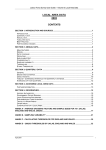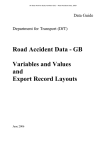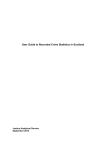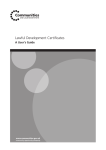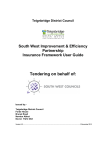Download Urban and rural area definitions: a user guide
Transcript
Urban and rural area definitions: a user guide On 5th May 2006 the responsibilities of the Office of the Deputy Prime Minister (ODPM) transferred to the Department for Communities and Local Government. Department for Communities and Local Government Eland House Bressenden Place London SW1E 5DU Telephone: 020 7944 4400 Website: www.communities.gov.uk Documents downloaded from the www.communities.gov.uk website areCrown Copyright unless otherwise stated, in which case copyright is assigned to Queens Printer and Controller of Her Majestys Stationery Office. Copyright in the typographical arrangement rests with the Crown. This publication, excluding logos, may be reproduced free of charge in any format or medium for research, private study or for internal circulation within an organisation. This is subject to it being reproduced accurately and not used in a misleading context. The material must be acknowledged as Crown copyright and the title of the publication specified. Any other use of the contents of this publication would require a copyright licence. Please apply for a Click-Use Licence for core material at www.opsi.gov.uk/click-use/system/online/pLogin.asp or by writing to the Office of Public Sector Information, Information Policy Team, St Clements House, 2-16 Colegate, Norwich NR3 1BQ. Fax: 01603 723000 or e-mail: [email protected]. This publication is only available online via the Communities and Local Government website: www.communities.gov.uk Alternative formats under Disability Discrimination Act (DDA):if you require this publication in an alternative format please email [email protected] Contents Introduction Section 1: Summary of definitions Section 2: Quick reference guide Section 3: Description & statistics for the urban settlement Annex A: Statistics and maps for 1991 Urban Settlements Annex B: The classification of 1998 administrative areas Annex C: The Supplementary Rural Definitions Annex D: Contacts $SSHQGL[ PDSV IURP $QQH[HV $ WR & Introduction Background and objectives 1. In 2001, the Office of the Deputy Prime Minister (ODPM) - then the Department of Transport, Local Government & the Regions (DTLR) - commissioned a consortium led by the South East Regional Research Laboratory (SERRL) at Birkbeck College (see endnote 1), to undertake a review of the definitions of urban and rural areas in use for policy purposes and statistical reporting. The need for such a study had been recognised for some time and was reinforced during preparation for the Urban and Rural White Papers (see endnote 2). In particular there was a clear need for a more consistent approach to the use of definitions. 2. The main objectives of the Review of Urban and Rural Definitions were: • to undertake a literature review of approaches to defining urban and rural areas, • to conduct consultations with government users of urban and rural definitions to identify the strengths and weaknesses of existing definitions, • to identify government needs for definitions of urban and rural areas, • to identify as small a set of definitions as possible, to meet a range of user needs, and • the review was also required to make recommendations on improvements to existing definitions and, if necessary, to outline approaches to the creation of new definitions. 3. The full research report and the recommendations have been published electronically at http://www.statistics.gov.uk/geography/urban_rural.asp 4. One of the main conclusions was that no single existing definition of urban and rural areas could meet the needs of all users. There was also a lack of clarity in the main central government departments around definitions in current use and around choosing a definition for particular policy and analysis purposes. 5. Therefore, whilst the research report recognised that more work needed to be done on spatial analysis to solve some of the problems of the existing definitions, it recommended that a user guide be written on the definitions currently in use. 6. The main Project Report identifies a number of different types of definitions of urban and rural areas that could be said to be 'core' in the sense that they meet a range of user needs and are more widely used than others. This document constitutes a User Guide to these definitions. 7. This User Guide serves five main purposes: • to present and explain the recommended definitions with a view to encouraging their use wherever they are suitable to user needs, • to describe a supplementary set of definitions as background information, • to present key summary statistics on the population and land area covered by the definitions, • to present maps to illustrate the definitions, and · to indicate characteristics of the definitions that might impinge upon the work of users. Meeting different user needs 8. The need for an urban/rural division tends to have arisen from the need to identify either the urban or the rural environment and thus the approaches taken to definitions are from either a predominately urban or rural point of view. 9. Those dealing with urban issues are primarily concerned with conditions in our towns and cities. As these have developed historically as the sites of human settlements and the associated man made infrastructure, the natural view of urban areas is one of built up 'settlements'. The boundaries of these settlements are determined by the outer limits of the physical structures and this approach consciously avoids the constraints of administrative area boundaries. 10. Whilst physical settlements, particularly smaller ones, are of considerable interest to those concerned with rural issues, the concept of rurality has often been more tied up with the social, economic and other circumstances associated with rural life. Of the options currently available, rural policy makers prefer to use a socio-demographic classification of administrative areas in order to identify rural areas. The definitions covered in this guide 11. The recommended set of definitions is set out in detail and a supplementary set is included as background information: • Recommended set: a narrow set of definitions which best meet most user needs. These are presented with practical guidance to avoid ambiguity in application. The set comprises two basic types: a. Urban settlements and b. Administrative area classifications • Supplementary set: several alternative definitions that have been used for specific applications or have been considered by users in the past are described. 12. Section 1 summarises all the definitions in the recommended and supplementary sets. Section 2 gives a practical usage guide to the recommended set and section 3 gives a full description of the recommended set with statistical summaries. The supplementary definitions are more fully described in Annex C. Next Steps 13. ODPM , ONS and Ordnance Survey are currently working on the updated version of the 1991 Urban Settlements (previously called urban areas). These 2001 Urban Settlements will be based on 2001 boundaries of urban land and population data from the 2001. They will form the basis of urban output from the 2001 Census, due out in 2003. 14. As touched on above, there is a mismatch between the urban approach and rural approach to definitions. Rural policy makers have found that to simply consider all areas outside urban settlements as rural does not satisfactorily meet their requirements; hence the development of the socio-economic classification of administrative areas to try to identify areas with rural characteristics. 15. The Countryside Agency, DEFRA, ODPM and ONS will be developing a new definition of rural areas that will better reflect current needs for the development of rural policy and be more consistent with the land-use based definition of urban areas. This is expected to be available in Summer 2003. Endnotes 1. The other members of the consortium were the Centre for Urban and Regional Development Studies at the University of Newcastle and the Department of Town and Regional Planning at the University of Sheffield. 2. Our Towns and Cities: the Future. Delivering an Urban Renaissance Cm 4911 TSO 2000, Our Countryside: the Future. A Fair Deal for Rural England, Cm 4909, TSO 2000 Section 1: Summary of definitions Recommended set There are two basic recommended definitions. Section 2 gives a practical guide to their use, Section 3 gives a full description with summary statistics and Annex A and Annex B identify the defined areas and illustrate them with maps. 1. Urban Settlement definition based on land use (England & Wales) This is the ODPM (DTLR) definition of 1991 Urban Settlements. They have in the past been called "Urban Areas" but to avoid confusion the term "Urban Settlements" will now be used. The basis of the definition is land with an irreversibly urban use and it is independent of administrative area boundaries. The 1991 Urban Settlements will be replaced by the 2001 Urban Settlements and these will be used from 2003. The definition appears as computer readable boundaries of all built up settlements with a minimum population of 1,000 and a minimum land area of 20 hectares. The user can choose a settlement size above which land is treated as urban for their purposes. To produce consistency in statistical reporting a cut off population of 10,000 is recommended for general purpose use. Adoption of this standard is encouraged where there are no particular reasons for setting a different level. Using this standard, all settlements of over 10,000 are treated as urban areas. All smaller settlements, together with all other land, are treated as rural areas. The Urban Settlement boundaries can be used in conjunction with any other geographically referenced data, such as postcodes and any digitised boundaries. 2. Administrative Area Classification definition based on socioeconomic variables (England) This is the Countryside Agency classification of rural and urban administrative areas based on a range of socio-economic characteristics of the population at local authority and ward levels. A county level classification, based on the ward level classification, is recommended with the reservation that it should be used only where there is no other choice. At a high geographical level it is less meaningful to describe an area as urban or rural, so this definition has limited use. Supplementary set: Three other definitions, appropriate for their designated purpose but not recommended for general use, are described in Annex C: 3. ONS Area Classifications 4. Local Government Finance sparsity measures 5. Countryside Agency Rural Services Survey Parishes Statistical comparison of the recommended definitions England Definition Urban population (millions) Rural population Urban land area Rural land area (millions) (hectares, (hectares, millions) millions) 42.4 4.6 1.1 12.0 37.8 9.2 0.9 12.1 Administrative area classification 35.6 13.9 1.7 11.3 Wards 35.6 13.9 3.0 10.0 Local Authorities 24.3 (Districts) 16.9 2.7 9.5 Urban Settlements Over 1,000+ population Over 10,000+ population Counties * * The county classification does not include the Unitary Authorities, which are included in the local authority (district) level classification. The Urban Settlement population is based on the 1991 Census. The administrative area population is based on the 1998 mid year estimates of population. Section 2: Quick reference guide This section provides practical summary advice for users to help them choose a definition. Full descriptions of the recommended definitions are given in section 3, together with maps and statistical summaries. 1. Urban Settlement definition based on land use: Description Purpose made boundaries for areas of built up land at least 20 hectares in area and with a population (1991 Census) of 1,000+. Recommended uses • To define the boundaries of urban settlements: the settlements defined have a population associated with them and thus different sizes of settlements can be selected to meet user needs by adjusting the cut-off point. • To produce a division of the country into urban and rural areas: this definition should be used where possible, i.e. when the user is not dependent on using administrative areas. Settlement size cut-off The population threshold of urban settlements that are treated as urban areas can be set anywhere from a minimum of 1,000 persons, to meet particular policy purposes. As a standard for general purposes a threshold population of 10,000 is recommended, with all settlements of over 10,000 treated as urban areas and smaller settlements, together with all other land, treated as rural. Coverage England and Wales. See contacts for other UK countries in Annex D. Combining with other data Once the user has chosen a population threshold, any data with a spatial reference (e.g. census enumeration district centroids, postcode or grid-referenced data or digital boundaries) can be used with the urban settlement boundaries on Geographic Information Systems. Maps and basic statistics Map A1 and map A2 in Annex A illustrate the urban settlements of more than 1,000 and 10,000 population size respectively for England and Wales. The web version of the guide provides the electronic 1991 Urban boundaries. The tables in Section 3 show summary statistics for Urban Settlements. The Urban Settlements with populations of 10,000 or more are listed in Annex A with their population counts. A list of all Urban Settlements (population 1,000+), with their population counts, is available with the web version of the User Guide. Access to further statistics Statistics are available for Urban Settlements (and Scottish Settlements) in Great Britain in a published volume: 1991 Census, Key Statistics for Urban and Rural Areas: Great Britain, ONS/GROS, 1997. Other volumes for non-standard regions cover England and Wales in more detail. Updates The 1991 Urban Settlements will be superseded by the 2001 Urban Settlements later in 2002 and these will form the basis of the Urban Settlements output from the 2001 Census in 2003. The minimum settlement size of the 2001 Urban Settlement boundaries and of the associated census outputs are under discussion. Other Comments This definition has been widely used, is simple in concept and fits well with the popular perception of urban areas as land that has been built upon. As the definition does not use administrative areas (except for sub-divisions), the Urban Settlements are a good representation of built up settlements of population. Depending on size, they typically include a number of, and/or bisected parts of, local authorities and wards. Rural policy makers often find that regarding all land outside the Urban Settlements as rural areas, is insufficient to meet their needs. Hence the development of the Area Classification method which was developed primarily to identify rural areas of England. However in terms of land use, the settlement method is the most effective way to obtain an Urban/Rural split of the country. 2. The administrative area classification definition based on socio-economic variables Description This definition operates on three geographical levels: ward, local authority and county. As stated earlier, the county level classification is only recommended when no alternative geographical level can be used. The overall method for the administrative areas classification was designed to identify those areas with certain social and economic conditions that were considered to give them a rural character. By default the remainder are considered urban, providing a classification of all areas as either urban or rural. Ward level definition This is derived from the LA definition below. A range of socio-economic variables was identified that produced similar results to the classification of rural areas at the local authority level. These variables were then applied to the 1998 wards, producing a classification of rural wards. Local Authority level definition The rural local authorities were identified for the Rural Development Commission by combining and amending three earlier classification systems. Further changes were then made to prepare a rural class of post 1998 Local Authorities. At the time of publication there are 145 rural LAs. County level definition A classification of the 1998 counties as urban or rural, according to the number of urban and rural wards as determined by the Countryside Agency ward level definition. Recommended uses • To identify rural areas for rural policy purposes: of the definitions currently available to identify rural areas, this is recommended and is regarded by those responsible for rural policy as best meeting their needs. • To produce a division of the country into urban and rural areas using administrative areas: this should be used when the user needs to identify administrative areas (i.e. wards and districts) as urban/rural, usually so that other data can be attached. For example, to calculate the waste recycling rate in urban/rural areas as the recycling rate is only available at district level. Coverage England. See contacts for other UK countries in Annex D. Combining with other data Any data that are arranged by local authority or ward (or can be assigned to these areas) can be matched to the classification. Maps and basic statistics Summary statistics appear in Section 3. The Rural Local Authorities are listed in Table B1, Annex B. The Rural Local Authorities and Rural Wards are illustrated in Map B1 and map B2, Annex B. The rural wards identified in the maps are as classified shortly before going to print. Minor recent changes are shown in the list on the web version. The Rural Counties (recommended with reservation) are listed in Table B2, Annex B. Access to further statistics Use of standard administrative areas means that a huge range of statistics is available from many sources. Lists of Rural Wards and Rural Local Authorities are available electronically with the web version of the User Guide. Other Comments Of the definitions currently available, those working on rural policy favour a system that identifies a class of administrative authorities as being rural in nature. The classifications recommended here are those currently used by the Countryside Agency for the State of the Countryside reports. The ward-level classification, sometimes known as 'Oxford- CA', was developed by the Social Disadvantage Research Centre, Oxford University. Section 3: Description & statistics for the urban settlement This section gives a more detailed description and consideration of the recommended definitions with statistical summaries. Parts 1 and 2 deal respectively with the urban settlements and the administrative area classifications. Part 3 provides a visual comparison of the two approaches to highlight the differences in outcome. Part 1: The 1991 urban settlements definition Introduction 1. There are three main approaches that can be adopted in the definition of urban areas: • A land use approach: identifies the closely built up area of settlements, i.e. the bricks and mortar 'footprint' of urban areas, • A functional area approach: identifies the hinterland over which a town is important in the provision of jobs, services and facilities, and • A density approach: uses the density of some phenomenon on the ground - usually population - but it could, for example, be households or buildings. 2. None of the methods is without its difficulties, whether in the conceptualisation of what we choose to regard as 'urban' or in the availability of data of the right type and in the right form to implement the definition. The actual settlement geography of a country also creates difficulties in applying and interpreting definitions. Decisions on the definition and delineation of urban settlements seldom work well in all circumstances and 'towns', however defined, tend in certain places, to merge physically and functionally with neighbouring towns and hinterlands. Historical development of the Urban Settlements approach 3. The land use approach used to derive the Urban Settlement definition can be seen as coming into use in the early 1980s. It was then that the Statistical Office of the European Communities requested a definition of urban agglomerations of 100,000 or more people in relation to the 1980 round of censuses. The then Office of Population Censuses and Surveys (OPCS) and the Department of the Environment (DOE) selected the land use approach to defining towns and cities. 4. A land use approach offered advantages in terms of comparability between countries (i.e. using an established base in topographic mapping). It also had a working antecedent in the 'developed areas' map produced by DOE and modelled on the National Land Use Classification (see endnote 3). As a result of this work a set of national and regional reports of statistics was produced by OPCS, derived from 1981 Census information (e.g. 1981 Key Statistics for Urban Areas, Great Britain, HMSO 1984). 5. The exercise was repeated for the 1991 Census using the same definition but updated for inter-censal changes in the extent of urban settlements (ONS/GROS 1991 Census Key Statistics for Urban and Rural Areas, HMSO 1997) (see endnote 4). This Urban Settlement definition as devised by the DOE, OPCS, OS and the Welsh Office for 1991, is the most widely and frequently used of any definition of urban England and Wales (see endnote 5). How the definition works 6. The Urban Settlements definition is based on '... the identification of areas with a land use that is irreversibly urban in character.' For urban land to qualify as an Urban Settlement it must extend for 20 hectares or more and have a population of at least 1,000. 7. It is useful to distinguish between the two elements of the process of obtaining a set of urban settlements and their associated statistical (census) information: the definition of tracts of urban land use, and the identification of urban settlements. Urban land use 8. In the 1991 exercise urban land was identified under the following categories: • permanent structures and the land on which they are situated (a 'built up' site); (see endnote 6) • transportation corridors (e.g. roads, railways and canals), which have built up sites on one or both sides, or which link up built up sites which are less than 50 metres apart, • transportation features such as airports and operational airfields, railway yards, motorway service areas and car parks, • mine buildings (but mineral workings and quarries are excluded), • any area completely surrounded by built-up sites, and • playing fields and golf courses that are surrounded by a built up area (otherwise they are excluded). Size and population limits 9. A pre-requisite for the identification of an urban settlement is that an area of urban land (as defined in paragraph 8 above) should extend for 20 hectares or more. Separate areas of urban land are aggregated if they are less than 200 metres apart. 10. For an area of urban land to qualify as an Urban Settlement it must have a minimum population of 1000. However, as there was no prior information on the 1991 populations of areas of urban land, a proxy threshold was applied by excluding areas with less than four 1991 Census Enumeration Districts (EDs). Steps in the identification process 11. The process of identifying urban areas thus involved the following stages: i. updated digital versions of the extent of urban land were produced using 1:10,000 scale Ordnance Survey field office data, ii. census EDs were assigned to tracts of urban land if their centroids were within the area of urban land or within a buffer zone 150 metres from its boundary, iii. those areas of urban land with four or more such EDs whose populations summed to 1000 were classified as urban settlements, iv. areas of urban land of 20 hectares or more and less than 200 meters apart which also had an aggregate of four or more EDs were linked together to form continuous urban settlements, v. agglomerations or 'multi-centre' areas were divided into 'sub-divisions', usually based on local authority boundaries. The end product 12. The definition leads to the creation of 1,859 distinct Urban Settlements in England and Wales (1,682 in England) with a population of just over 44 million or 90 per cent of the total. In England they comprise 1.1m hectares of land in aggregate (8.3 per cent of the surface area). The largest urban settlement is Greater London with a resident population of 7.7 million, whilst the smallest are defined to have around 1,000 persons. 13. The Urban Settlements for populations of 1,000+ and 10,000+ are shown on Map A1 and Map A2 respectively. Tables 3.1.1 and 3.1.2 below summarise the corresponding populations and land cover associated with these two cut-off points. Table 3.1.1: Population and land area for Urban Settlements over 1,000 population (this is the smallest settlement size available) England & Wales 1991 population (millions) % of total population Land area (hectares, millions) % of total area Total land 49.9 100 15.1 100 Urban Settlements 44.7 90 1.1 8 Rural Areas 5.1 10 14.0 92 Separate figures for England and for Wales are given in Annex A. Table 3.1.2: Urban areas over 10,000 population: the recommended basis of an urban/rural division England & Wales 1991 population (millions) % of total population Land area (hectares, millions) % of total area Total land 49.9 100 15.1 100 Urban Settlements 39.6 79 1.0 7 Rural Areas 10.3 21 14.1 93 Separate figures for England and for Wales are given in Annex A. 14. Table 3.1.3 gives a summary of the Settlements with population of 750,000 or more. The Urban Settlement of West Yorkshire includes Leeds, Bradford, Wakefield, Huddersfield and a number of other 'towns' that are merged into a single Urban Settlement (see Map A3). The West Midlands Urban Settlement includes, among other places, Birmingham, Solihull, Walsall, West Bromwich and Wolverhampton. The largest settlement in Wales is Cardiff with a population of some 308,000. Table 3.1.3 Urban Settlements Over 750,000 Resident Population 1991 1991 population % of total Urban Land area (millions) (hectares, Population (England) thousands) % of total Urban land area (England) Greater London 7.7 18.0 162 14.9 West Midlands 2.3 5.4 60 5.5 Greater Manchester 2.3 5.4 53 4.9 West Yorkshire 1.4 3.4 36 3.3 Tyneside 0.9 2.1 21 1.9 Liverpool 0.8 2.0 19 1.7 Total 15.4 36.3 350 32.2 Using the Urban Settlements definition 15. The wide acceptance and varied usage of the Urban Settlements definition is due to its transparency, the existence of a set of high resolution digital boundaries suitable for use with Geographic Information Systems (see endnote 7) and the availability of a range of census and other statistics. Names, codes and sub-divisions 16. Larger urban settlements are internally sub-divided and have Census statistics reported for them. Sub-divisional boundaries are usually based upon local authority district 16 boundaries. Urban areas and their sub-divisions are coded in the digital version of the data set using a six-character code in the form: D84100 (Liverpool). The first four elements of this Urban Area Serial Number or 'UASN' indicate entire urban areas. The final two digits can be used to indicate sub-divisions of larger urban areas. For example, Liverpool comprises eight sub-divisions numbered from D84101 (Crosby) to D84108 (Prescot). Freestanding urban areas with no sub-divisions should have a UASN terminating in two zeros (00). 17. Areas separated by less than 200 metres are treated as being the same urban settlement and their codes share the same first four characters. If the areas are separated by less than 50 metres they are given the same full six character codes. 18. Both individual urban settlements and aggregations of urban settlements are assigned names. In the case of aggregations some are familiar town names (e.g. Leeds), whilst others are less obviously associated with a conventional 'town' (e.g. Thanet). There are also composite names such as 'Scarborough/Scalby'. This form of naming stems, in many circumstances, from the operation of the '200m rule' for creating contiguous urban areas (see endnote 8). 19. Map A2 shows agglomerations of urban settlements whose populations sum to at least 10,000. Sub-divisions are discernible within many urban areas of this size. Many urban settlements appear familiar (drawn at this scale), as large and major cities: for example Plymouth, Bristol, Leicester, Liverpool, Leeds, etc. Others may be less familiar as 'towns', for example Chesterfield/Staveley/Wingerworth Urban Settlement and Thanet Urban Settlement (comprising Broadstairs, Margate and Ramsgate). Such aggregations may or may not relate to the policy analysis task in hand. The effects of rules on close neighbours 20. In the vast majority of cases the 200m contiguity rule which 'joins' otherwise separate urban areas together produces results that are intuitively plausible in terms of what is accepted, with some local knowledge, as an urban 'place'. In some instances, however, the rule can lead to less obvious results. Map A3 shows the West Yorkshire Urban Area, which comprises no fewer than 25 components forming a convoluted chain, some parts of which are linked by only a few houses. 21. Map A4 looks at the eastern edge of the Greater Manchester Urban Area, which includes the separate settlement of Longdendale - they are merged according to the rules for defining Urban Areas. The Urban Area of Glossop/Hollingworth is separated from Greater Manchester (including Longdendale) by a slightly bigger gap, and is treated as a separate Urban Area. The inset shows the gap in detail, to demonstrate how this could change with only small scale development. Comparison with administrative area boundaries 22. Although Urban Settlements are simple in concept and seemingly straightforward in definition, users should be conscious of the underlying definition and their independence from administrative area boundaries. The rules for defining tracts of urban land can, for example, lead to highly irregular and intricate patterns. Visual inspection of mapped boundaries provides a much better appreciation of urban morphology and the differences between urban and administrative boundaries. 23. Map A5, Map A6 and Map A7 show the relationship between urban settlements and other administrative units at different geographic scales and for different sizes of Urban Settlement. This relationship is significant when calculating the amount of land in an Urban Settlement that falls within a local authority boundary and when deriving certain kinds of information for Urban Settlements. The figures emphasise the importance of having a 'map view' of Urban Areas. 24. Map A5 shows the West Midlands and Coventry/Bedworth Urban Settlements alongside current local authority districts. The main Urban Settlement boundaries are very different to the local authority boundaries, though the latter are in many cases followed by the boundaries of the Urban Settlement sub-divisions. 25. In Maps A6 and A7 the scale changes to show the relationship between ward and urban settlement boundaries for a medium sized Urban Settlement (Norwich), and for a small Urban Settlement (Braintree). The boundaries related to them are 1998 wards. In the case of Norwich Urban Settlement, selected wards might make an acceptable boundary for the Urban Settlement for some purposes, whereas for Braintree they might be less acceptable. Visual inspection of this kind might be advised when gathering ward related data for smaller Urban Settlements. 26. Map A8 depicts the pattern of Urban Settlements and urban land for part of East Anglia. The grey areas represent urban land that does not qualify as an Urban Settlement. Failure to qualify can result from the way in which the capture of census Enumeration Districts is affected by the size and/or the configuration of the urban land or ED boundaries. Reliance only on Urban Settlements as an indicator of very small rural settlement is thus likely to be misleading. Small settlements and specific applications 27. Some policy areas, for example in meeting local housing needs through urban housing capacity studies, require a more flexible approach to the identification of small urban areas. For such purposes the term 'urban' can embrace all settlements that can contribute to a sustainable pattern of development. This could include Urban Settlements with a population below 3,000, referred to as 'rural' in Planning Policy Guidance 3 (Circular 6/98), and could potentially include settlements that are smaller than the 1,000 minimum threshold of the Urban Settlement definition. 28. Some applications involve the identification of small 'rural settlements'. This can be to apply policy measures in support of rural services that tend to be based in such settlements and serve a wider area. In such cases rural policy can be applied by means of identifying the smaller settlements within the Urban Settlement definition, rather than by identifying the broader rural areas. Limitations with very small settlements 29. The effect of excluding urban land if the population of the four EDs allocated to them did not sum to 1000 has some significance for those interested in small settlements. OPCS/GROS suggest that this resulted in ' ... the exclusion of some areas of urban land with more than 1,000 population but very few above 2,000' (OPCS/GROS, 1997, paragraph 4.15). So far as can be ascertained, no assessment was made of the impact of this rule in terms of the number and location of small settlements not identified as Urban Settlements. Land outside the Urban Settlements 30. The Urban Areas definition has sometimes been used to give information for 'rural' England and Wales by subtracting Urban Area populations and land areas from some larger population/area either nationally or within smaller areas, e.g. counties (see endnote 9). This 'residual' approach is transparently simple, and straightforward to understand, but it has a number of limitations as a way of defining rurality and tends not to be a definition of choice for those with rural policy interests. Urban land boundaries 31. Digital boundary sets are available for both Urban Settlements and urban land. Where these are held together care is needed to distinguish one from the other. Urban land may, of course, be of policy interest as part of the total urban land cover. Endnote 3 Department of the Environment, National Land Use Classification, HMSO 1975. In fact, in the period 1955- 1975, land use/land intensity methods were the most prevalent in official definitions of urban areas. One of the rare official attempts to depict urbanism as a set of functional (commuting) areas appears in Royal Commission on Local Government in England 1966-69, Vol 3, Cmnd 4040 II, HMSO June 1969 (Maps) and illustrates well the problems involved. 4 Statistics for Scottish urban localities are included in the volume though they are based on an approach to definition that does not focus on land use as such. 5 There is a different approach to defining urban areas and assigning their population levels in Scotland. See Scottish Settlements, Urban and Rural Areas in Scotland, GROS 2001 and 1991 Census, Key Statistics for Urban and Rural Areas: Great Britain, ONS/GROS, 1997 paragraphs 4.21-4.36 6 For this purpose 'land' is defined as the ground covered by a permanent structure and any ground enclosed by, or closely associated with, such a structure. 7 Ordnance Survey, Urban Areas_91, User Manual, 1994 (mimeo) 8 Areas of urban land not qualifying as Urban Areas are not named. 9 See, for example, Summary Tables 1-14 in 1991 Census, Key Statistics for Urban and Rural Areas, ONS/GROS, 1997. Part 2: The rural administrative area definitions Further information on Rural Areas Introduction 1. The approach to defining Rural Areas has been very different from that used in identifying Urban Settlements. Rather than focusing on settlements, there has been a tradition of classifying administrative and other areas based upon a range of characteristics deemed to indicate the various social and economic dimensions of 'rurality'. 2. Rural Areas defined in this way have the advantage of being based in a wide range of nationally consistent data (often derived from the census), and of relating directly to agents of rural policy delivery such as local authorities, but have generally lacked important dimensions associated with 'rurality' such as the size, form and pattern of settlement. (see endnote 10) Such dimensions are only imperfectly captured by, for example, measures of population density. They also raise the question of geographic scale in relation to rural definitions: at national, district and local scales, for example, different aspects of rurality/rural settlement become important in both definitional and policy terms. Historical Development of the rural classifications 3. Of the various methods used to classify rural administrative areas, three systems are recommended. These operate at the ward, local authority (district) and the county levels. Whilst the methodologies differ, they are related in a manner that produces results with many features in common. The following sequence of descriptions reflects the chronological relationship of the ward level classification, firstly to the earlier Local Authority classification whose effect it seeks to emulate, and secondly to the recent aggregation of the ward level results to reach a classification of counties. The underlying local authority district classification 4. Developed for the Rural Development Commission, this method relied on a combination of three earlier classifications which relied on a range of socio-economic variables: the National Council of Voluntary Organisations (Redefining Rural Districts in England), the ONS 1991 Classification of Local and Health Authorities (see supplementary definitions) and a DoE list of additional rural authorities prepared for the 1995 Rural White Paper. A ward level model to replicate the local authority system 5. The ward level definition takes a range of socio-economic variables, selected to produce similar results to the local authority level classification, and applies these to the 1998 wards. It was developed in 2000 for the Countryside Agency by the Social Disadvantage Research Centre (SDRC), at the Department of Social Policy and Social Work, Oxford University. Using the ward system to aggregate to counties 6. This is a recent application of the ward level classification to the post 1998 Counties, created to cover circumstances in which an urban/rural distinction at that level of geography cannot be avoided. Identifying the rural administrative areas Ward level methodology 7. A range of socio-economic variables was identified that corresponded well to the division of rural and non-rural authorities in the Local Authority level definition. This was then applied to the 1998 English Wards to identify those that were rural. By this means, the proportion of the population of England that is captured as rural is similar (28%) at the two geographical levels. The classification, sometimes known as the 'Oxford-CA' was then amended slightly by the Countryside Agency following consultation with interested parties. 8. The definition was calculated by applying a logistic regression model to a range of socioeconomic variables in order to: firstly, identify which variables were associated with the Countryside Agency's district level definition; and secondly, to use those with a significant association to predict which wards were rural. The variables used in the model are set out below. Variables used at the ward level 9. The following data were used in the ward level classification. • Population Density: ratio of ward level population size (from IMD 2000) to ward area in hectares • Ratio of economically active population to the economically inactive population: ratio of ward level population aged 16 to 59 to the sum of the population aged 15 and below and aged 60 and over. All population estimates from IMD 2000. • Percentage of people who use public transport: ward level numbers of people who use trains or buses to travel to work. The denominator is the ward-level number of economically active people aged 16 and over. Both variables from the 1991 Census. • Percentage of people in agriculture/forestry/fishing: ward level numbers of people in agriculture, forestry and fishing. The denominator is the ward level number of economically active people aged 16 and over. Both variables from the 1991 Census. • Percentage of people in primary production (mining/energy /water): ward level numbers of people in mining, energy and water. The denominator is the ward level number of economically active people aged 16 and over. Both variables from the 1991 Census. • Percentage of people who are ethnically non-white: ward level numbers of people who describe their ethnic group as a category other than white. The denominator is the ward level population. Both variables from the 1991 census. Evolution of the local authority classification 10. As described above (under Historical Development), this classification was built from a combination of three previous systems. Broadly speaking, inclusion in two of these lists qualifies an area as rural. The Countryside Agency made further changes to take account of local government re-organisation up to 1998. The recommended definition for the classification of local authorities was used by the Countryside Agency for the State of the Countryside Reports and is sometimes known as SOCCODE (no connection to Standard Occupational Classification). Aggregating wards to counties 11. This classification assigns an urban or rural status to each of the 1998 counties, according to the proportion of urban and rural wards within the area, as determined by the ward level classification. Counties in which the majority of wards are rural are themselves classified as rural. The end products 12. Under the ward level classification, 4,076 of the 8,414 wards in England are defined as rural (48%). A population of approximately 13.9 million people live in these rural wards, which is over one-quarter (28%) of the total population in England (1998 based population estimates). The spread of Rural Wards in England is illustrated in Map B1. A list of rural and urban wards is included in the web version of the guide. 13. The local authority level definition identifies 145 Rural Local and Unitary Authorities. As with the ward level classification, 28% of the population live in the rural local authorities. These are listed in Annex B, Table B1. Their distribution across the country is illustrated in Map B2. 14. The County level classification produces 28 rural counties and 13 urban counties. The rural counties contain 41% of the total county population and 78 % of the total county land area. This division does not include the Unitary Authorities, which are covered in the local authority (district) level classification. Summary of statistics for administrative area classifications 15. The following table provides some summary information comparing the population and land area covered by the classifications of administrative areas of England at different geographical levels. England Administrative Area Classification Wards 1998 population (millions) % of total population Land area (hectares, millions) % of total land area Total land 49.5 100.0 13.0 100.0 Rural Areas 13.9 28.1 11.3 86.8 Urban Areas 35.6 71.9 1.7 13.2 49.5 100.0 13.0 100.0 13.9 28.2 10.0 76.9 Urban Areas 35.6 71.8 3.0 23.1 Local Authority Total land Districts/Unitar y Authorities Rural Areas Counties Total land 41.2 100.0 12.1 100.0 Rural Areas 16.9 41.0 9.5 77.9 Urban Areas 24.3 59.0 2.7 22.1 Using the rural classification definition 16. The recommended classification of Local Authorities offers the most broadly inclusive definition of rurality. The ability of this classification to separate 'urban' from 'rural' areas has been improved by the designation of some of the urban Unitary Authorities but there are, inevitably, a range of Local Authorities that are difficult to classify particularly where there are single urban centres surrounded by predominantly rural hinterlands. 17. The Ward level variant of the Countryside Agency classification, modelled on the Local Authority level division of rural and urban areas, reduces these difficulties, but care is needed when applying this classification at detailed local scales in predominantly rural areas. Ward level 18. The two main scales of delineation - whole wards and whole local authorities - differ in the proportion of the total land area that is classified as rural (at ward level 86.8%, compared to 76.9% for local authorities). This is because, at the ward scale, it is easier to separate urban centres from their surrounding rural areas. Thus, in the case of Carlisle, the urban centre stands out as non-rural in a setting of almost completely rural surrounding wards. This is not achieved with the local authority classification (see below). 19. The national pattern of rural and urban wards produced by the classification clearly identifies the main conurbations and cities as clusters of urban wards. The classification is, however, more problematic when applied to more generally rural areas at a local scale. Map 3.5 shows the Countryside Agency's classification of rural wards with urban 23 settlements superimposed upon them for a part of the Eastern Region centred roughly on Cambridge. Also shown are tracts of urban land (see Section 3, part 1). 20. Many areas of urban land shown on Map 3.5 are in fact small settlements that do not meet the population size threshold required for recognition as an urban settlement. A number of cases can be seen where small settlements 'weight' the profile of the ward into the non-rural category, whereas some of the larger named centres are contained within rural wards. Local authority district level 21. As Map B1 indicates, this definition of rural areas excludes the main conurbation areas and many district and unitary local authorities that are closely defined around urban areas. Thus Exeter, Torbay and Plymouth stand out as tightly defined urban authorities in the predominantly rural South West. Cambridge, Norwich, Ipswich and Great Yarmouth are similarly defined as urban in predominantly rural East Anglia. 22. The scale of delineation of this definition - i.e. whole local authorities - creates anomalies when classifying authorities characterised by a significant amount of open countryside and one or more relatively large service centre. An example is Carlisle. Carlisle District is not 'rural' under this definition despite containing a single large centre set in an extensive rural hinterland. The urban area of Carlisle accounts for approximately three quarters of the District's 103,000 residents but the population density of the District as a whole, at 99 persons per sq km, is about the same as that of Mid Suffolk. 23. In contrast, the largest urban settlement in Mid Suffolk (Stowmarket), contributes only just over 13,000 residents to a district total of 81,000. Thus, although the rural part of Mid Suffolk has a higher settlement density than the rural part of Carlisle, the size of the urban centre places Carlisle District as non-rural while Mid Suffolk is firmly in the rural category. County level 24. At the higher geographical level it becomes very difficult to produce a classification that gives a meaningful representation of the urban/rural nature of the areas, many of which contain a considerable rural expanse whilst also including substantial components of a clearly urban nature. This classification is inevitably crude and is only included in the recommended list of definitions for use where there is no alternative to describing areas at this level in terms of an urban/rural split. A cautionary note 25. One definition that has received recent attention is that created by Tarling et al (1993) for the Rural Development Commission. This was used in the Performance and Innovation Unit Report on Rural Economies (1999) and in the Cabinet Office Report 'Sharing the Nation's Prosperity' (2000). This classified all English Local Authority districts into five classes: remote rural, accessible rural, coalfield areas, urban districts and metropolitan districts. The Tarling definition is not recommended. It is mentioned here to prevent confusion with the recommended definition, with which it shares some characteristics. Endnote 10 Applied to its full logical extent within the 'rural domain' the 'urban land use' approach to definition would be used to identify settlements below 1000 population up to and including isolated dwellings. This is essentially the approach taken in the Housing Corporation/Rural Development Commission Rural Settlements Gazetteer, 1998. See also the approach to rural settlement/rural area definition in Scotland: Scottish Settlements, Urban and Rural Areas in Scotland, GROS 2001 20 Part 3: A visual comparison of the two main definitions As described earlier the two main definitions, with their different bases, do not match. When put together, the areas of land identified as urban in the land use/urban settlements definition and the areas identified as rural in the administrative area classification definition do not cover the total land area, and in some places they overlap. This is illustrated in Map 3.3, which shows Urban Settlements (10,000+) overlaid on the 1998 Local Authorities classified as rural and urban. Map 3.4 shows how the urban wards are a better reflection of the Urban Settlement boundaries than the urban local authorities. A more detailed illustration is given in Map 3.5 which shows the classification of rural wards with urban settlements superimposed for a part of the Eastern Region around Cambridge. Also shown are tracts of urban land that do not qualify as Urban Settlements. The recommended means of dividing the country into urban and rural areas is the Urban Settlement definition with a 10,000+ population cut-off. Use of an area classification definition to produce a general urban/rural distinction (rather than as a means of looking at specific rural issues) is only suggested where the distinction must be made for administrative areas. Annex A: Statistics and maps for 1991 Urban Settlements Table A1; Urban/Rural land area summary for Settlements of 1,000+ Country total for urban Settlements with population 1000+ Corresponding Rural areas land area Percent of total (see (hectares, Endnote 11) thousands) land area Percent of total (hectares, thousands) England 1,087 8.3 11,957 91.7 Wales 62 3.0 2,014 97.0 England & Wales 1,149 7.6 13,971 92.4 Urban/Rural land area summary for Settlements of 10,000+ Country Urban Settlements with population 10,000+ Corresponding Rural areas land area Percent of total (see (hectares, Endnote 12) thousands) land area Percent of total (hectares, thousands) England 939 7.2 12,104 92.8 Wales 47 2.3 2,030 97.7 England & Wales 986 6.5 14,134 93.5 Table A2 Urban/Rural population summary for Settlements of 1,000+ Country Total for urban Settlements with population 1000+ Corresponding Rural areas 1991 Percent of total population (thousands) 1991 Percent of total populations (thousands) England 42,443 90.2 4,611 9.8 Wales 2,300 81.1 534 18.9 England & Wales 44,744 89.7 5,146 10.3 Urban/Rural population summary for Settlements of 10,000+ Country Total for urban settlements for population 10,000+ Corresponding Rural areas 1991 population (thousands) Percent of total 1991 populations Percent of total (thousands) England 37,807 80.3 9,247 19.7 Wales 1,776 62.6 1,059 37.4 England & Wales 39,583 79.3 10,306 20.7 Table A3 Summary for Urban Settlements (1,000+) by size of population: England and Wales Population Number of Range (1991settlements resident persons) 1991 population (thousands) Percent of total urban poulation Land area (hectares, thousands) Percentage of total urban land area covered 750,000+ 6 15,359 34.4 350 30.5 250, 000 749,999 19 7,020 15.7 174 15.2 100,000 249,999 37 5,470 12.2 142 12.4 50,000 99,999 61 4,336 9.7 114 9.9 25,999 49,000 100 3,439 7.7 94 8.2 10,000 24,999 254 3,923 8.8 111 9.7 3,000 - 9,999 684 3,685 8.2 111 9.7 1,000 - 2,999 698 1,476 3.3 52 4.5 Total 44,744 100.0 1,150 100 1,859 Table A4: Urban Settlements (1991) with population over 10,000: England and Wales Endnotes 11. In each case the total comprises that for England, Wales, and England and Wales as a whole. 12. In each case the total comprises that for England, Wales, and England and Wales as a whole. Annex B: The classification of 1998 administrative areas Table B1: classification of 1998 administrative areas: the rural LAs Region Local Authority District North East Darlington UA Hartlepool UA Middlesbrough UA Redcar & Cleveland UA Stockton-on-Tees UA Chester-le-Street Derwentside Durham Easington Sedgefield Teesdale Wear Valley Alnwick Berwick-upon-Tweed Blyth Valley Castle Morpeth Tynedale Wansbeck Gateshead Newcastle-upon-Tyne North Tyneside South Tyneside Sunderland Blackburn with Darwen UA Blackpool UA Halton UA Warrington UA Chester Congleton Crewe and Nantwich Ellesmere Port and Neston Macclesfield Vale Royal Allerdale Barrow-in-Furness Carlisle Copeland Eden South Lakeland Bolton Bury Manchester Oldham Rochdale Salford Stockport North West Rural areas Rural Rural Rural Rural Rural Rural Rural Rural Rural Rural Rural Rural Rural Rural Rural Yorksire & Humberside East Midlands Tameside Trafford Wigan Burnley Chorley Fylde Hyndburn Lancaster Pendle Preston Ribble Valley Rossendale South Ribble West Lancashire Wyre Knowsley Liverpool St Helens Sefton Wirral East Riding of Yorkshire UA City of Kingston upon Hull UA North East Lincolnshire UA North Lincolnshire UA York UA Craven Hambleton Harrogate Richmondshire Ryedale Scarborough Selby Barnsley Doncaster Rotherham Sheffield Bradford Calderdale Kirklees Leeds Wakefield Derby UA Leicester UA Nottingham UA Rutland UA Amber Valley Bolsover Chesterfield Derbyshire Dales Erewash High Peak North East Derbyshire South Derbyshire Blaby Charnwood Harborough Hinckley and Bosworth Melton North West Leicestershire Rural Rural Rural Rural Rural Rural Rural Rural Rural Rural Rural Rural Rural Rural Rural Rural Rural Rural Rural Rural Rural West Midlands East Oadby and Wigston Boston East Lindsey Lincoln North Kesteven South Holland South Kesteven West Lindsey Corby Daventry East Northamptonshire Kettering Northampton South Northamptonshire Wellingborough Ashfield Bassetlaw Broxtowe Gedling Mansfield Newark and Sherwood Rushcliffe County of Herefordshire UA Stoke-on-Trent UA Telford and Wrekin UA Bridgnorth North Shropshire Oswestry Shrewsbury and Atcham South Shropshire Cannock Chase East Staffordshire Lichfield Newcastle-under-Lyme South Staffordshire Stafford Staffordshire Moorlands Tamworth North Warwickshire Nuneaton and Bedworth Rugby Stratford-on-Avon Warwick Birmingham Coventry Dudley Sandwell Solihull Walsall Wolverhampton Bromsgrove Malvern Hills Redditch Worcester Wychavon Wyre Forest Luton UA Peterborough UA Southend-on-Sea UA Rural Rural Rural Rural Rural Rural Rural Rural Rural Rural Rural Rural Rural Rural Rural Rural Rural Rural Rural Rural Rural Rural Rural Rural Rural London Thurrock UA Bedford Mid Bedfordshire South Bedfordshire Cambridge East Cambridgeshire Fenland Huntingdonshire South Cambridgeshire Basildon Braintree Brentwood Castle Point Chelmsford Colchester Epping Forest Harlow Maldon Rochford Tendring Uttlesford Broxbourne Dacorum East Hertfordshire Hertsmere North Hertfordshire St Albans Stevenage Three Rivers Watford Welwyn Hatfield Breckland Broadland Great Yarmouth Kings Lynn and West Norfolk North Norfolk Norwich South Norfolk Babergh Forest Heath Ipswich Mid Suffolk St Edmundsbury Suffolk Coastal Waveney Camden City of London Hammersmith and Fulham Kensington and Chelsea Wandsworth Westminster Hackney Haringey Islington Lambeth Lewisham Newham Southwark Tower Hamlets Rural Rural Rural Rural Rural Rural Rural Rural Rural Rural Rural Rural Rural Rural Rural Rural Rural Rural Rural Rural Rural Rural South East Barking and Dagenham Bexley Enfield Greenwich Havering Redbridge Waltham Forest Bromley Croydon Kingston upon Thames Merton Sutton Barnet Brent Ealing Harrow Hillingdon Hounslow Richmond-upon-Thames Bracknell Forest UA Brighton and Hove UA Isle of Wight UA Medway UA Milton Keynes UA Portsmouth UA Reading UA Slough UA Southampton UA West Berkshire UA (Newbury) Windsor and Maidenhead UA Wokingham UA Aylesbury Vale Chiltern South Buckinghamshire Wycombe Eastbourne Hastings Lewes Rother Wealden Basingstoke and Deane East Hampshire Eastleigh Fareham Gosport Hart Havant New Forest Rushmoor Test Valley Winchester Ashford Canterbury Dartford Dover Gravesham Maidstone Sevenoaks Shepway Rural Rural Rural Rural Rural Rural Rural Rural Rural Rural Rural Rural Rural Rural Rural Rural Rural Rural South West Swale Thanet Tonbridge and Malling Tunbridge Wells Cherwell Oxford South Oxfordshire Vale of White Horse West Oxfordshire Elmbridge Epsom and Ewell Guildford Mole Valley Reigate and Banstead Runnymede Spelthorne Surrey Heath Tandridge Waverley Woking Adur Arun Chichester Crawley Horsham Mid Sussex Worthing Bath and North East Somerset UA Bournemouth UA City of Bristol UA North Somerset UA Plymouth UA Poole UA South Gloucestershire UA Swindon UA Torbay UA Caradon Carrick Kerrier North Cornwall Penwith Restormel Isles of Scilly East Devon Exeter Mid Devon North Devon South Hams Teignbridge Torridge West Devon Christchurch East Dorset North Dorset Purbeck West Dorset Weymouth and Portland Cheltenham Cotswold Rural Rural Rural Rural Rural Rural Rural Rural Rural Rural Rural Rural Rural Rural Rural Rural Rural Rural Rural Rural Rural Rural Rural Rural Rural Rural Rural Rural Rural Rural Rural Rural Forest of Dean Gloucester Stroud Tewkesbury Mendip Sedgemoor South Somerset Taunton Deane West Somerset Kennet North Wiltshire Salisbury West Wiltshire Rural Rural Rural Rural Rural Rural Rural Rural Rural Rural Rural Rural Table B2: A classification of Urban and Rural Counties (1998) This classification is based on the proportion of wards within the county that are identified as rural by the Countryside Agency ward level classification. If more than 50% of the wards are rural then the County is classified as rural, otherwise it is classified as urban. This definition is only recommended where it is essential to consider urban and rural areas at the County level. In general, the practice of assigning urban or rural labels at this level of geography is not recommended. Rural Counties % of wards in County that are rural Buckinghamshire 51 Lancashire 56 Leicestershire 57 Staffordshire 57 Derbyshire 58 West Sussex 59 Bedfordshire 60 Northumberland 62 Hampshire 63 Warwickshire 63 Northamptonshire 64 East Sussex 67 Oxfordshire 69 Cheshire County 72 Cumbria 73 Worcestershire 74 Wiltshire 80 Cambridgeshire 81 Gloucestershire 82 Suffolk 82 Norfolk 82 Devon 88 North Yorkshire 89 Dorset 90 Lincolnshire 91 Somerset 91 Shropshire 93 Cornwall and Isles of Scilly 99 Urban Counties % of wards in County that are rural Tyne and Wear 0 London 0 West Midlands 1 Greater Manchester 1 Merseyside 4 South Yorkshire 7 West Yorkshire 8 Hertfordshire 19 Surrey 28 Durham County 41 Nottinghamshire 45 Essex 45 Kent 48 Annex C: The Supplementary Rural Definitions 1. Introduction 1.1 The supplementary definitions described in this annex are not recommended for general use but have been included because they have been used for specific applications or have attracted some attention as possible methods of identifying rural areas. These are: a. Two classifications of administrative areas produced by the Office for National Statistics (see endnote 13). These use 1991 census data to classify 1991 Wards and 1998 Local Authorities in to families of areas in which the residents share certain sociodemographic features. b. A definition adopted by the (then DTLR) Local Government Finance group for measuring the sparsity of population within Local Authority areas and incorporated within SSA calculations. Two variants of this approach are described. The first captures approximately the same population as the recommended rural definition and is referred to here as 'Broad Definition'. The second captures approximately the same population as the ONS classification and is referred to as the 'Narrow' Definition. c. A definition comprising the selection of parishes used by the Countryside Agency for administering the Rural Services Survey and some other aspects of policy analysis. 2. Summary Statistics 2.1 The basic comparative statistics of the proportions of the national (England) area and populations covered by each of the selected definitions are shown in the following table. The definitions are presented according to their geographic level of delineation. Table A3.1: The Recommended and Supplementary Rural Definitions: Comparative Areas and Populations England Rural land area (%) Rural population (%) 76.9 28.2 Local Authority Level Countryside Agency Local Government Finance (Broad Definition) 78.7 28.0 ONS'98 38.8 9.7 Local Government Finance (Narrow Definition) 45.1 9.8 Countryside Agency (1998 Base) 86.8 28.1 ONS Wards (1991 base) 47.6 11.2 Approx 85 Approx 15 Ward Level Parishes Countryside Agency Rural Services Survey 3. The ONS Area Classifications 3.1 The ONS classifications of administrative and health authority areas are fundamentally different in approach from that taken by the Countryside Agency in that they are produced as part of a broader exercise to characterize all areas of the country into a range of families or groups using socio-demographic variables from the 1991 Census of Population. 3.2 The classifications were not designed to define urban or rural areas. Some users have, however, used them as such. This is more a result of the way the families and groups have been named (providing a likely choice for someone in search of a definition), than an indication that the classifications are seen as suitable means of defining urban and rural areas. 3.3 The families or groups cover a much broader range of types than simply 'urban' or 'rural' and are derived empirically from the evidence of patterns of association ('similarity') amongst the selected socio-demographic indicators. District Clusters 3.2 This form of classification was first carried out for local authorities and health authorities using data from the 1991 Census (see endnote 14). A subsequent classification of authorities followed which took account of 1998 'post re-organisation' administrative boundaries (see endnote 15). In this classification there are seven 'families', one of which is designated as:Rural (I) alongside Urban Fringe (II), Coast and Services (III), Prosperous England (IV), Mining Manufacturing and Industry (V), Education Centres and Outer London (VI), and Inner London (VII). The Rural family is then broken down into two 'groups' Rural Amenity (A) and Remoter Rural (B). 3.3 The ONS district level of 'rural and 'non-rural' areas is shown in Map C1. The range of alternative types within the classification greatly reduces the land area and population included in the 'Rural' classification in comparison with the Countryside Agency's simpler and broader definition. In England only 9.7% of the population is included, which is about one third of that included by the Countryside Agency selection of authorities. This level of rural population is repeated exactly in Wales. 3.4 Within the ONS family structure there are two particular groups that subsume areas that might otherwise be considered to be 'open countryside' (Map C2) One is the so-called, 'Coastal and Service' family. This is strongly represented in Wales, the South West and parts of the South East, including many local authorities that have quite extensive rural components. However, this family contains within it significant variations in the character of its constituent authorities. Thus, although many members of this family have rural tendencies, others do not. Thus it is difficult to see such members as Leeds, Darlington Bristol and Cardiff, as a supplement to the more directly identified 'Rural' family. 3.5 The other family accounting for significant areas of what the Countryside Agency's definition would classify as rural is the 'Prosperous England' family. Concentrated largely in south and central England, this grouping includes the ring of commuter areas immediately beyond the Greater London boundary, growing towns in the South East and substantial swathes of areas in East Anglia and the Midlands. 3.6 'Prosperous England' reflects accurately the fact that these are parts of the country that have been under the most intense development pressure for the last twenty or thirty years as jobs and residents have dispersed into the towns and villages of the 'core' area of south and central England. Again, however, this family does not form a credible extension to the relatively small Rural family. 'Prosperous England' includes many of the quite densely developed authorities on the fringes of London, in addition to many of the urban unitary authorities in the South East, East and Midlands. It is a genuinely mixed group of commuter areas, free-standing towns and areas of open countryside. Ward Clusters 3.7 The ONS clustering approach has a ward-level variant that complements the local authority classification discussed above. The ward boundaries used are for 1991, matching those used in the 1991 Census of Population. Wards whose data are suppressed to maintain anonymity within the 1991 Local Base Statistics are not included in the classification. 3.8 Although the broad approach and data used at the ward scale are similar to those used in the reclassification of the 1998 Local Authorities, the range of area types differs in detail. For the earlier exercise two rural 'groups' were identified: Rural Areas and Rural Fringe. These are combined together in Map C3. The range of 'competitor' groups is also different but there is a 'Prosperous Areas ' group and a 'Middling Britain' group that contain some of the areas classified as 'Prosperous' in the 1998 LA level re-classification. However, there is no group that is directly comparable to the Coast and Service family found in the 1998 LA version. 3.9 The outcome of the ward-based approach is a classification that includes a slightly larger population and area in comparison with the local authority scale. About 11.2% of England's population is captured as 'rural' at the ward level compared with only 9.7% for 1998 local authorities. 3.10 Despite these detailed differences in classificatory structure, the broad regional pattern of rural wards has quite strong similarities with the local authority scale. The strongest concentrations of rural wards are still in Devon, Dorset, Norfolk, Lincolnshire, N.Yorkshire and the Welsh Borders. There are still relatively few rural wards in the South East, particularly in those areas relatively close to Greater London. Summary 3.11 The key characteristic of both ONS classifications is that their purpose is not to act as a definition of rurality that is based on any prior concept of what rurality represents. Rural clusters are only produced because their members share similar profiles on the selected range of social, economic, demographic and housing variables and that, taken together (and when represented on a map), these members 'appear' to an informed observer to be 'rural'. 3.12 There are, however, many variables over which similarity may be measured and it is clear, particularly in the 1998 analyses, that the presence of relatively large numbers of well educated and relatively affluent residents serve to link many potentially 'rural' areas with neighbouring urban areas in the key growth zones of the country. 3.13 In essence, in the ONS classifications, 'growth' has dominated 'rurality' which, in itself, may be an interesting reflection of what is happening to the English countryside. By subtracting growth areas that may be 'rural', this classification produces a restricted definition of what is rural i.e. it is 'weighted' towards the relatively poor rural authorities and wards. 4. Local Government Finance 'Sparsity' Measures 4.1 As the name implies this approach to identifying rural areas is a byproduct of the formulae used to determine central government support to local authorities. However, although specialist in nature, they represent - via the notion of low levels of habitation relative to land area - one widely accepted approach to defining rurality. 4.2 A key component of these formulae is a measure of sparsity based on aggregating Enumeration District (ED) resident populations, classified by their sparsity and grouped into local authority units. There are two definitions: between 4 and 0.5 persons per hectare EDs are classified as 'sparse', whilst those with less than 0.5 pph are classified as 'supersparse'. The score for a local authority is the sum of its population in sparse EDs plus twice the sum of its population in super-sparse EDs. 4.3 In itself, however, this numerical approach does not classify authorities into 'rural' or 'non-rural'. Rather, it produces a ranking of EDs according to their relative 'sparseness'. To illustrate two variants based on this approach a 'broad' and a 'narrow' definition have been defined. The 'broad' definition selects the top 150 authorities that include approximately the same population as the Countryside Agency local authority definition. The 'narrow' definition captures a population similar to the ONS classification of 1998 local authorities. Interestingly, this requires only the top 62 sparsely populated local authorities to 'capture' the equivalent level of population. 4.4 The two classifications are illustrated in Map C4 and Map C5. Both maps show that the strong underlying link between both the Countryside Agency and ONS classifications and relative sparsity. In comparison with the Countryside Agency definition, there are a number of marginal changes. Thus in the case of Carlisle discussed earlier there 63 is a shift from non-rural to rural using the sparsity approach. Overall, however, the same broad pattern of authorities emerges from both classifications. 4.5 The 'narrow' sparsity definition is also quite similar to the ONS family of Rural Areas. The main differences arise in parts of the East Midlands and the East where some relatively sparse areas in Cambridgeshire, Suffolk, Leicestershire and Northamptonshire are included in the ONS Prosperous Areas family. Summary 4.6 Measures of 'sparsity' can clearly serve as effective discriminators between rural and non-rural authorities and can go a long way towards reproducing the classifications determined by methods based on socio-demographic measures. The main problem is that no established classification of rurality makes use of this measure. A wide range of classifications of areas could be produced using different types of sparsity measure and different sparsity threshold values. It would, however, be difficult to judge which was the most appropriate for any particular purpose. 5. Countryside Agency Rural Services Survey Parishes 5.1 An Urban Settlement population of 10,000 has been used in the past by the Rural Development Commission and by the Countryside Agency as a broad threshold value distinguishing urban settlements from smaller 'rural' settlements and the remaining rural land. For the Rural Services Survey 2000 (RSS2000)16, the same population cutoff point was applied to parishes but the population within the parish boundary was taken, with no use being made of Urban Settlement boundaries or their population counts. 5.2 Map C6 shows the parishes selected for participation in the survey - areas shown as blank on the map do not have parishes. Selected parishes are those whose resident population in 1991 did not exceed 10,000. In addition, the Countryside Agency consulted widely with County authorities and Rural Community Councils to identify parishes which were felt not to meet the spirit of being truly 'rural'. A very small number of parishes with populations slightly over the 10,000 threshold were re-introduced following this consultation. 5.3 The 1997 base of selected parishes was re-used in RSS2000 incorporating all those parishes surveyed in 1997 that can be traced through to the current set of boundary definitions. In a small number 5.4 The RSS2000 parishes constitute a further definition of rurality focused on an important level of administration and policy in rural areas. It is a broad definition of rural covering approximately 85 percent of the land area of England (about the same as the Countryside Agency Ward Level Classification) and containing about 15 percent of the resident population. It is instructive to compare this with the Countryside Agency ward classification population level of 28 percent which arises from the specific exclusion of the more populous parishes which removes many small towns in predominantly rural areas from the survey. 5.5 The main operational problem with parish-based classifications is that there is little contemporary data collected for these units outside the Rural Services Surveys and the system of agricultural returns. Much of the contextual social and economic data thus dates back to the 1991 Census. Endnote 13 Office for National Statistics, The ONS Classification of Local and Health Authoroties of Great Britain: revised for authorities in 1999, GSS 1999. 14 Wallace M and C Denham, The ONS Classification of Local and Health Authorities of Great Britain, HMSO 1996 15 Bailey, S, J Charlton, G Dollamore and J Fitzpatrick, The ONS Classification of Local and Health Authorities of Great Britain, H<SO 1999. 16 The Countryside Agency asks Parish Clerks to provide a wide range of information for its surveys of rural service provision undertaken every three years. Not all parishes are included in the Survey and not all areas of the country have parishes defined for administrative purposes. 64 of cases parishes will show as 'non-selected' in places where boundaries have been disrupted by recent revisions. Annex D: Contacts Office for National Statistics General enquiries: [email protected] Information on the work of ONS Geography and geography of the UK: http://www.statistics.gov.uk/geography/default.asp Information on the availability of census data: [email protected] Office of the Deputy Prime Minister Simon Connell Office of the Deputy Prime Minister 3/K10 Eland House Bressenden Place London SW1E 5DU Tel: 0207 944 5505 [email protected] Department of the Environment, Food and Rural Affairs Chris Gibbins Rural Statistics Unit Room 146, Foss House King's Pool 1-2 Peasholme Green York YO1 7PX Tel: 01904 455 414 [email protected] Countryside Agency Justin Martin Research, Data and Information Branch Countryside Agency Cheltenham GL50 3RA Tel: 01242 533 268 [email protected] Scotland General Registrars Office for Scotland For settlement statistics, boundaries and other boundary products see: http://www.groscotland.gov.uk/grosweb/grosweb.nsf/pages/scosett Scottish Executive, Survey Manager For the Scottish Household Survey, which provides an urban rural division by combining settlements with data on remoteness from urban centres, see: http://www.scotland.gov.uk/stats/bulletins/00115/00115-00.asp and a more detailed bulletin at http://www.scotland.gov.uk/shs/docs/shsb-00.asp For more information on the Scottish Household Survey, contact the survey manager at the Scottish Executive: http://www.scotland.gov.uk/shs/ Wales Stuart Neil Agriculture and Rural Affairs Statistician Welsh Assembly Government Tel: 029 2082 6822 [email protected] Northern Ireland Chris Morris Statistics and Research Branch Department for Social Development Block 3, The Village Castle Buildings Stormont BELFAST, BT4 3UD Tel: 028 905 2280 [email protected] Appendix: maps from Annexes A to C

































































